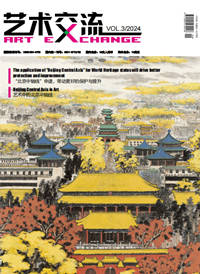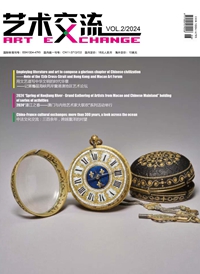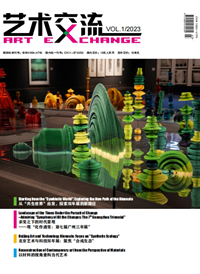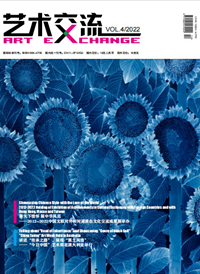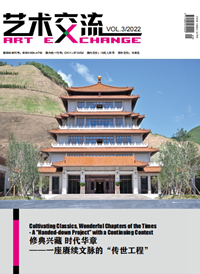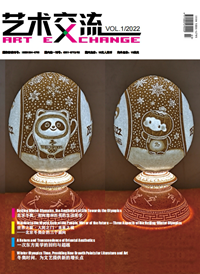Restoring Historical Memory, Retrieving Cultural Spirit
Memory Collection of My Father ZHANG Naiqi

Red Plate of JI (Qing Dynasty)

Tile-pattern Bronze Vessel for Food (Western Zhou Dynasty)

Kui-dragon-pattern Bronze Holder for Ritual (Spring and Autumn Period)

Jade Ring (Neolithic Age)
Sentiment of Patriotism---Exhibition of Cultural Relics Donated by ZHANG Naiqi has been held at National Museum of China. With some donated by my father in early years, most of the exhibits are selected from over a thousand pieces of cultural relics donated after the Cultural Revolution. My father had long devoted himself to cultural relics and archeology. However, under the turbulent social environment, he devoted his energies mainly to democratization and industrialists to save the country. After 1949, he then began to systematically collect cultural relics and gradually became a collector. ZHENG Xinmiao, former President of the National Palace Museum, once said that the collection of Mr. Zhang was relatively complete, "covering almost all aspects of ancient life".
Years of Memory
Before 1966, my family lived in a courtyard at No.30, Dengcao Alley. The original residence here was CHEN Shutong, who later moved away and the Office Administration of State Council assigned the house to my father.
Sitting to the south and facing the north, the courtyard is not large and the orientation is not so good, but every corner exudes the traditional culture and charm.In addition to the sofa, the majority are hardwood classical furniture, displaying the bronze, porcelain and calligraphy and painting collected by my father. And the collection reaches about five to six thousand pieces at its most.
My favorite thing to do when I was young was to open the cabinets one by one and hold the antiquities from the jewelry boxes and asked the dynasties and origins of these things from my father. And every time, he explained patiently, and found some representative artifacts to show me from time to time. I was gradually infected by the habit of favoring old stuff. But out of psychology of a child, what interested me the most was the ancient weapons. There was a time when my father showed me a bronze dagger that was finely crafted. The sword was not rusty at all, and shone with a soft luster. The whole body was decorated with a regular grid pattern. He pointed out that the special feature of this sword was that the grid decoration might be as a result of some chemical process. The written materials left by his father once described the sword as follows: "The bronze sword of the Warring States Period is as sharp as a razor, and the sword body is full of corroded patterns, and the copper smelting technique and the pattern method are all worthy of study. This is a very rare reference for research. "He also talked about the collection of another bronze sword in other places:The inscription of the wire seals are four Chinese characters as "Exclusive for Emperor Wu".
My father once had a collection of famous bronzes of great significance in writing archeology, called "Er Si Bi Qi You" (Now in the possession of the National Palace Museum), which is known to all. As far as I can see, there were also dozens of other large and small objects and 7-8 bronze drums of the Shang and Zhou Dynasties, which featured extremely high value.
Porcelain is a big item in my father's collection and his jade collection is also very rich. I once asked my father: You have collected so many artifacts, why not calligraphy? He said that there were too many fake paintings and calligraphy, and the eyesight of collecting paintings and calligraphy is not what ordinary people could have. I do not have the eyesight of ZHANG Boju and ZHANG Xiaobin, that’s why he mainly collected bronze, porcelain, jade and miscellaneous items. I asked again: Have you been fooled? My father said there was more than once, if not fooled, how could he learn to identify the authenticity? You have to pay tuition fees if you want to be a collector. If there is a beautiful thing in the counterfeit, though the year is not long
enough, I also want to collect as a work of art.
Opportunity and Popularity
Among the well-established figures of the older generation, my father is known for his passion for cultural relics and archeology. However, prior to 1949, under the turbulent social environment, he devoted his energies mainly to democratization and industrialists to save the country and did not collect in a systematical manner. He began collecting artifacts and forming series systematically at the start of the year 1949 after he arrived in the liberated areas.
The historical relics were scattered and destroyed mostly related to social unrest. At that time, violent social changes and the revolutionary enthusiasm of the general public did not make the majority of people aware of the value of cultural relics. At that time, the market price of cultural relics was so low that it reached an unimaginable level compared with that of today. This is an opportunity for collectors who wish to systematically collect cultural relics.My father began to collect cultural relics scattered in the community when he was in the northeastern part of the country. After settling in Beijing in 1949, his spare time was mostly devoted to patronizing the cultural relics market, mainly the shops of Longfu Temple and Glass Street, as well as stalls at East Dadi (Bridge of Hongqiao at present).
With the historical opportunities of collection, people also need the fate in this regard. The advantage of my father was that my father has forged a harmonious relationship with a number of experts and collectors, which has enriched his collection in return. Among these friends, Mr. SUN Yingzhou, a veteran of the antiquarian line, has helped him "Identify" and famous collectors Mr. YE Gongchuo, Mr. ZHANG Boju and Mr. ZHAO Zhenjing and others also once discussed with my father concerning the cultural relics.
For collected cultural relics, my father would often ask some friends to appreciate together. However, he is a hands-on and self-employed person in sorting the categories. He has custom-made a large number of brocade boxes to protect those unpacked artifacts. When a cultural relic is about to be put into the box, he often writes some words or thoughts on the box, describing the source, category and characteristics of the collection, and sometimes noting the comments of Mr. SUN Yingzhou or his own on these artifacts, which I have seen a lot.
Due to regular contacts, some antiquarians have become his friends and naturally contacted him directly when finding great artifacts.
The fund sources of my father's collection of cultural relics, on one hand, is his salary and on the other hand the capital he withdrawn from Shangchnan Enterprice co., which he established in Chongqing during the Anti-Japanese War with a fast growth. He came to Taiwan after that and purchased the Taiwan Sugar Company. The situation of the civil war turned down sharply. As Chiang Kai-shek was ready to use Taiwan as the last base, my father had transferred the company and founded a Hong Kong-Kowloon real estate company in Hong Kong. The operation was most successful.
My father has a clear mind regarding the public and the private. After returning to serve as a government official in the mainland in 1949, he thought he was no longer suitable to run a business and submitted his resignation to the board of directors. As the company was unsuccessfully chaired, the company ceased business. And he gradually withdrew his own investment in the company for collecting cultural relics, ready to be donated to the country in future.
Change for Dedication
My father is a political activist and economist. Due to his interest in culture, collection has become his hobby. At the beginning after settling in Beijing, he had plenty of time and space for collection. Later, he served as the councilor of the Administrative Council and chief of the compilation committee and later the minister of the Food Ministry since the first plenary session of the Chinese People's Political Consultative Conference and the founding of new China, he became very busy. Before donating the cultural relics to the state in 1954, he had accumulated threeroom relics with rather complete categories, many of which were of most high quality.
There is a letter from my father to Mr. ZHENG Zhenduo in December, 1953, the full text is as follows:
To ZHENG Zhenduo, Director of Bureau of Social and Cultural Affairs
Dear Xidi:
I will move out in forty days. To save troubles, I hope your bureau can receive some of my cultural relics before or soon after my moving. Otherwise, it would be very laborious if I move them to my new place and your bureau after that. On the other hand, it is too unreliable if I leave them here for a long time, taking up other people's houses are very troublesome.Please think about it, we shall make the decision face-to-face .
ZHANG Naiqi
December 9, 1953
From the content of the letter, he had already expressed his willingness of donation. He urged Mr. ZHENG Zhenduo to receive the relics as soon as possible as he was required to move from the Dayang Yibin alley to the Dengcao alley. Eight days later, he also sent a letter to LI Tongcun, Chairman of Shangchnan Enterprice co., saying: "All the money I use was spent on the purchase of antiquities and my salary has also been paid in this regard. And I plan to donate all the relics I collected to the Ministry of Culture of Central Government.
In the early spring of 1954, Mr. ZHENG has sent six experts from the Forbidden City to receive artifacts. My father opened all the cabinets for their selection, which has lasted for a month or so, and over a thousand items were selected. Like the Yu Zu Ding You of Shang Dynasty, Ya Fu Yi Gui, Duo You of Western Zhou Dynasty, the sword of the Spring and Autumn King, Bamboo Tripod with Taotie Pattern of Qing Dynasty, White-glazed Jar of Xing Kiln, Green-glazed Five-hole-covered Bottle of Longquan Kiln and other fine relics were all chosen as the collection of the Forbidden City. The department of cultural relics had proposed opening a donation exhibition for my father, but it was not agreed by him. He also donated a batch of cultural relics, which he hasn’t even counted, to the Chinese People's Committee for the Defense of World Peace the following year.
My father has always regarded cultural relics as the cultural wealth of the entire nation. He once told the colleagues of the Ministry of Food: "I am totally belonging to the public in work. But regarding the relics appreciation, now I can only do that with main focus on the public and the private as a supplement, and I do have some personal considerations. I have already donated more than a thousand antiques to the Social and Cultural Affairs Bureau and the Chinese People's Committee for the Defense of World Peace. However, I have to leave some for myself, which will be donated to the country when I pass away. I regard these antiques as the Chinese culture and art in appreciation, which is an indispensable part of my spiritual life. It is also a good teacher for me to study and enhance the scientific knowledge of culture and arts.
Owning Temporarily
LI Qingzhao mentioned in Order of Jinshilu: However, there will always be a loss of possession, and there will be a convergence after departure, this is the common ground in the world. Someone lost a bow, someone got a bow, why bothering? Hence my purpose of writing down the whole story is hoping to leave a bit of caution for the future generations who love the elegant antiquities.
"Trickle of water merging into the sea", the private collection donated to the public museum and turned into a social and cultural wealth is a very common phenomenon in a civilized society. ZHANG Jian, a giant in the modern industry of China, once founded Nantong Museum with personal financial resources and collections. In addition, the names of more than 600 donors are also engraved in the "Jingren Ranking" of the National Palace Museum.
The former collectors are some people with humanistic sentiment and patriotism who collect in a silent manner, never considering them as personal belongings and donating generously. It is not for showing themselves, but regarding the cultural relic as the cultural wealth of the Chinese nation and entrusting them with museums with the hope that these artifacts are properly protected. Such a spirit of culture is thoroughly connected in that generation, as is the case in museums: the great southbound movement of antiques of the Forbidden City launched prior to the outbreak of AntiJapanese War left many hardships in the process of separation and disappearance. Experts and staff were able to fulfill their duties and did not suffer any loss of the cultural relics.
After the "Cultural Revolution" in 1976, it embraced the reform and opening-up. Civil collection revived with economic development, but the values of collectors have changed not only from ancient times, but also different from the modern times, and even from that of the 1950s, showing the increasingly purpose-oriented utilitarian feature, caring for public welfare is growing indifferent and donations for the good of the public have become most rare. This change of social concept of collection also reflects the long absence of civic education in our country.
It has been over 60 years up to now since my father began to collect cultural relics in a systematical manner. I have acquired much life insight through reviewing my father's legendary experience as a collector. Nowadays, in my 60s, I will be in a pleasant mood to admire cultural relics or visit art exhibitions, and also be invited to appreciate friends’ new and old collections from time to time. Collection, nothing more than a once-owned process, cannot be kept forever. It is enough if the antiquities have been associated with you and bring you plentiful pleasure. There is countless information of people and family residing in each piece of antiquities, hiding stories of prosperity and decline, joy and sorrow, which we might never know. The donation of cultural relics to the museum like my father is a predictable arrangement for life. His pursuit of social and cultural dedication enables the value of cultural relics to be reflected and his own cultural spirit can be renewed without any regrets.
Restoring historical memory and retrieving cultural spirit are the prerequisite for the rejuvenation of a nation.




